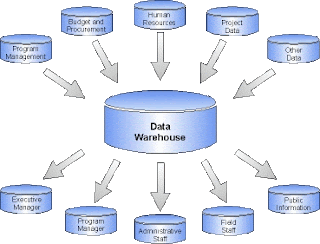1.Describe the roles purpose of data warehouse and date marts in an organization.
-The roles of data warehouse is a logical collection of information gathered from many different operational databases that support business analysis and decision-making tasks.The primary purpose of a data warehouse is to aggregate information throughout an organization into a single repository in such a way that employees can make decisions and undertakes business analysis activities.
-data marts-contains a subset of date warehouse information and to distinguish between data warehouses and data marts,think of data warehouse as having a more organizational focus and data marts as having focused information subsets particular to need of given business unit such as finance or production and operations.
2.Compare the multidimensional nature of data warehouse with the two-dimensional nature of databases.
-data base contain information in a series of two dimensional tables which means that you can only ever view two dimensional of information at one time.A relational database contains information in a series of two dimensional tables.A dimension is a particular attribute of information In a database warehouse and data marts information is multidimensional it contains layers of columns and rows.Each layer in a data warehouse or data marts represents information according to an additional dimension.Dimensions could such things as products,promotion,stores,category,region.stock price,date,time and even the weather.The ability to look information from different dimensions can add tremendous business insight.
3.Identify the importance of ensuring the cleanliness of information throughout an organization.
- It maintain high quality data in the data warehouse or a database warehouse or data mart is extremely important.
-The roles of data warehouse is a logical collection of information gathered from many different operational databases that support business analysis and decision-making tasks.The primary purpose of a data warehouse is to aggregate information throughout an organization into a single repository in such a way that employees can make decisions and undertakes business analysis activities.
-data marts-contains a subset of date warehouse information and to distinguish between data warehouses and data marts,think of data warehouse as having a more organizational focus and data marts as having focused information subsets particular to need of given business unit such as finance or production and operations.
2.Compare the multidimensional nature of data warehouse with the two-dimensional nature of databases.
-data base contain information in a series of two dimensional tables which means that you can only ever view two dimensional of information at one time.A relational database contains information in a series of two dimensional tables.A dimension is a particular attribute of information In a database warehouse and data marts information is multidimensional it contains layers of columns and rows.Each layer in a data warehouse or data marts represents information according to an additional dimension.Dimensions could such things as products,promotion,stores,category,region.stock price,date,time and even the weather.The ability to look information from different dimensions can add tremendous business insight.
3.Identify the importance of ensuring the cleanliness of information throughout an organization.
- It maintain high quality data in the data warehouse or a database warehouse or data mart is extremely important.
A process is that weeds out and fixes or discards inconsistent,incorrect,or incomplete information,contact information in
an operational system,standardizingcustomer name from operational
system,information cleansing activities and accurate and complete
information quality management.
4.Explain the relationship between business intelligence and data warehouse.
-business intelligence is the information that people use to support their decision-making efforts.It a business started automating more and more systems,more and moreinformation become available.
-business intelligence is the information that people use to support their decision-making efforts.It a business started automating more and more systems,more and moreinformation become available.
-data warehouse a logical collection of information- gathered from many different operational databases-that supports business analysis activities and decision-making tasks.
can refer to this....
-



